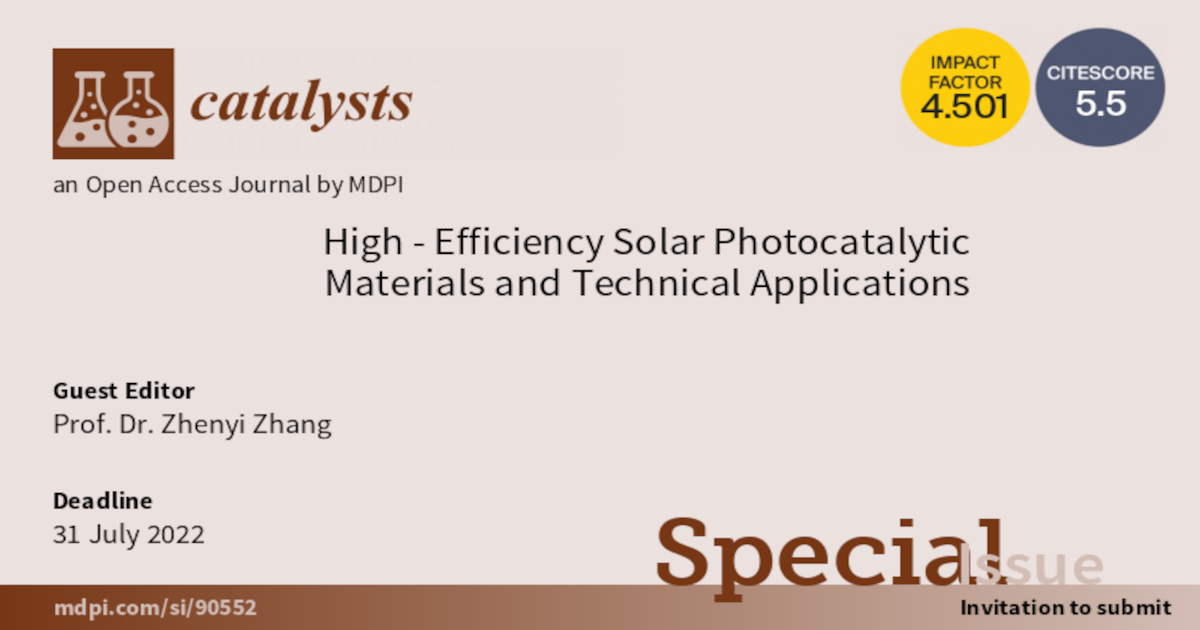High-Efficiency Solar Photocatalytic Materials and Technical Applications
A special issue of Catalysts (ISSN 2073-4344). This special issue belongs to the section "Photocatalysis".
Deadline for manuscript submissions: closed (15 August 2023) | Viewed by 10271

Special Issue Editor
Interests: design and synthesis of low-dimensional heterostructured semiconductor materials for photoelectric functional applications, including photocatalytic water splitting, photocatalytic CO2 reduction, photocatalytic pollutant decomposition, gas sensors, humidity sensors, and so on
Special Issue Information
Dear Colleagues,
Photocatalysis technology has been regarded as a promising “green” strategy for dealing with the ever-increasing global energy crisis and environmental pollution. This technology can not only convert inexhaustible solar energy into chemical fuels through splitting water into H2 or reducing CO2 into high-value hydrocarbon fuels but also mineralize organic pollutants through a photo-oxidation process. The design and development of highly efficient semiconductor photocatalysts have been at the forefront of photocatalytic technical applications, which have made much progress to date. However, several drawbacks still hinder the photocatalytic activity of single semiconductor photocatalysts, such as narrow light-absorption range, poor light utilization efficiency, rapid recombination of photoinduced charge carriers, as well as high reaction overpotential. To address these critical problems, recent research efforts have focused on the development of heterostructured semiconductor photocatalysts by combining one semiconductor with other photosensitizers, such as energy-band matchable semiconductors, plasmonic nanostructures, perovskite nanostructures, heteropolyacids, and so on. This Special Issue aims to design and develop new types of high-efficiency solar photocatalytic materials (or heterostructures) and investigate their potential applications in the fields of energy conversion, environment remediation, chemical organic synthesis, and so forth.
Kind Regards,
Prof. Dr. Zhenyi Zhang
Guest Editor
Manuscript Submission Information
Manuscripts should be submitted online at www.mdpi.com by registering and logging in to this website. Once you are registered, click here to go to the submission form. Manuscripts can be submitted until the deadline. All submissions that pass pre-check are peer-reviewed. Accepted papers will be published continuously in the journal (as soon as accepted) and will be listed together on the special issue website. Research articles, review articles as well as short communications are invited. For planned papers, a title and short abstract (about 250 words) can be sent to the Editorial Office for assessment.
Submitted manuscripts should not have been published previously, nor be under consideration for publication elsewhere (except conference proceedings papers). All manuscripts are thoroughly refereed through a single-blind peer-review process. A guide for authors and other relevant information for submission of manuscripts is available on the Instructions for Authors page. Catalysts is an international peer-reviewed open access monthly journal published by MDPI.
Please visit the Instructions for Authors page before submitting a manuscript. The Article Processing Charge (APC) for publication in this open access journal is 2200 CHF (Swiss Francs). Submitted papers should be well formatted and use good English. Authors may use MDPI's English editing service prior to publication or during author revisions.
Keywords
- Photocatalysis
- Water splitting
- Hydrogen generation
- Solar-to-fuel conversion
- CO2 reduction
- Pollutant degradation
- Plasmonic photocatalysts
- Semiconductor heterostructures
Benefits of Publishing in a Special Issue
- Ease of navigation: Grouping papers by topic helps scholars navigate broad scope journals more efficiently.
- Greater discoverability: Special Issues support the reach and impact of scientific research. Articles in Special Issues are more discoverable and cited more frequently.
- Expansion of research network: Special Issues facilitate connections among authors, fostering scientific collaborations.
- External promotion: Articles in Special Issues are often promoted through the journal's social media, increasing their visibility.
- Reprint: MDPI Books provides the opportunity to republish successful Special Issues in book format, both online and in print.
Further information on MDPI's Special Issue policies can be found here.





